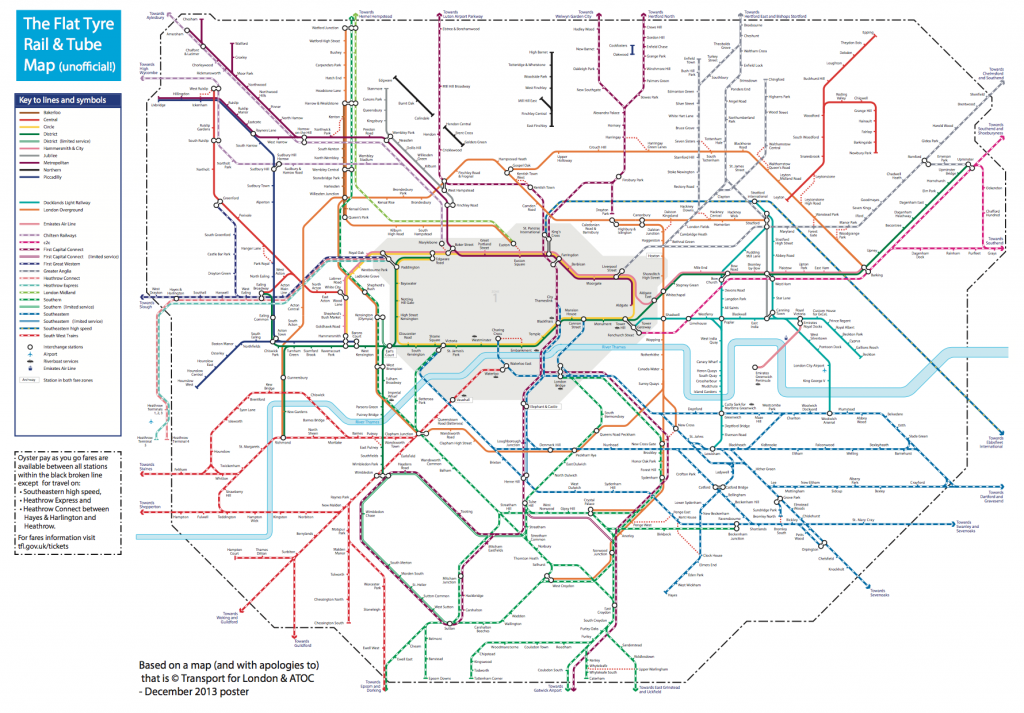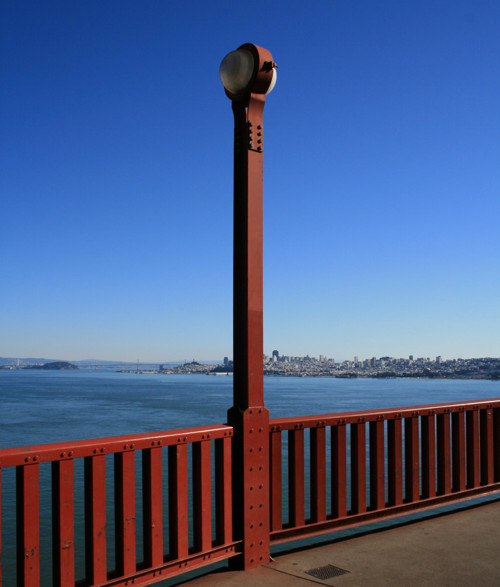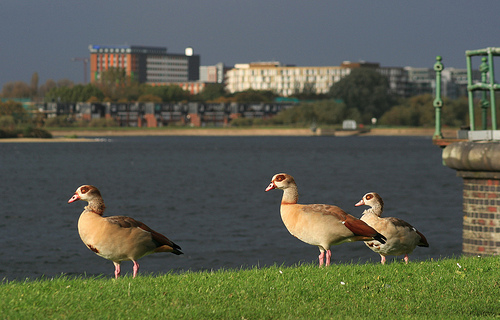
So… I went on a holiday last month to San Francisco. I’d been planning on a return to the west coast of America since a trip to Vancouver for a conference in summer 2012, and San Francisco is one of those places I’d seen a lot about but never actually visited. The excuse to finally make a visit was the combination of (1) a series of orienteering sprint events – Sprint the Golden Gate (2) cheap-ish flights – £525 return, and (3) various friends from school and university who have made it over there on a semi-permanent basis.
As December approached, the orienteering series was looking a bit shaky – permit problems, which I can strongly relate to with the inevitable permissions headaches that arise year on year with the London City Race. But I went ahead and entered. US orienteering races are extremely expensive to enter compared with the UK/Europe, due to insurance and expensive park permits needing to be included, but conversely the GBP/USD exchange rate has shifted quite a bit recently, making the US a cheaper place to visit than historically.
I arranged to crash on the floor of a friend’s apartment in the Marina District, and to meet up with four others who I knew were probably nearby. I had the Lonely Planet guidebook but the plan wasn’t to look at it that much! As is reasonable for a city of such beauty, I took a lot of photos (400+) and the best 70 are linked in the text below, and can be viewed on one page on Flickr.
Tuesday – Arriving
The flight over was OK, although the route was intriguing – going very far north, further than I thought we would, so that we were quickly into the Arctic Circle and, as happens at this time of year, even though it was the middle of the day, it got pretty dark outside. To possible take advantage of the unusually strong jetstream, which has been plaguing the UK with storms for the last month, we actually “overshot” the west coast of North America and headed right over Vancouver, before heading south-east to San Francisco itself.
I had a few hours before my friend appeared from work, so I got the BART into downtown, picked up a T-Mobile $3/day SIM, accidentally walked straight past the famous Apple Store and a bikeshare docking station, and wandered down to the Ferry Building, from where there is a great view of the Bay Bridge which currently has an evening lightshow. I then did a long, gradual walk anti-clockwise along Embarcadero, first heading past the new location of the Exploratorium and some outdoor exhibits, and then to Pier 39, a slightly kitsch but popular food/gift arcade. Taking a side-route out, I completely unexpectedly came straight across the sealion colony, which was making an amazing racket. Apparently they’ve been there pretty much since the pier was built. Checking the map, Russia Hill sounded like an interesting name, so I headed south, eventually making it to the hill up some impressively steep roads and flights of steps. I then headed over to the famous squiggly bit of Lombard and then a long walk along Chestnut down to the Marina District.
Wednesday – Walking
This was the big walk day – I walked 18 miles in the end. From the Marina District I headed north to the marina itself, to visit the Wave Organ sculpture there – with great views of Alcatraz Island and the Golden Gate Bridge – we’ve all seen a thousand images of it but there is no substitute for the thrill of seeing the most famous bridge in the world for the first time in real life. I then walked around the park at the pseudo-Greco-Roman Palace of Fine Arts, and then back to the shoreline, through Crissy Field and to the Golden Gate Bridge itself – the way on to the bridge wasn’t immediately obvious so I overshot a bit at first, and ended up under the bridge at Fort Point. After various tourist pics from and of the bridge, I headed off the far end of the bridge into Marin County. The walking route north doesn’t go much further (no pavement) so I had to get a bus from here to Sausalito, where I had half an hour to wander around – little to see though – before getting the ferry back to San Francisco. The ferry takes a great route, passing nearby Alcatraz Island, and with a symmetrical view of the Bay Bridge, before ending appropriately at the Ferry Building.

After grabbing lunch at some boutique stalls in the Ferry Building (think Borough Market but even fancier) I walked down Market to the famous cable car turnaround at Powell. After the inevitable wait in the tourist queue, watching cars getting rotated, I got a cable car over to Hyde and Bay, before walking back up Hyde – very steep – and down the wiggly bit of Lombard again. Then along Lombard to Telegraph Hill and the Coit Tower (closed) for a 360-degree sunset view. Down the wrong set of steps to Levi Plaza, back up the right set, down again to Downtown, around the Transamerica Pyramid, the Bank of America plaza & tree, and Union Square with its Christmas tree and Macy’s. Then a loop up to and around Chinatown and Dragon Gate, and a long walk along Geary, through Tenderloin (a starkly downtrodden area), to Japantown with its concrete pagoda and a pocket park. More hills found on the way back to the Marina District!
Thursday – Silicon Valley
First, a slow bus through rush hour, right across San Francisco to the Caltrain terminal. I made my connection with a minute to spare and got the huge and impressive Caltrain “Baby Bullet” double-decker train service down to Palo Alto. I then spent an hour walking to and around Stanford’s otherworldly university campus – including longer than planned in the unexpectedly massive Stanford team shop – before walking back to Palo Alto to get a lift to the Facebook HQ for a quick tour and lunch with a friend from university. Then an hour’s walk through American suburbia all the way back to Palo Alto station.
The original plan was to visit a friend at the Googleplex, but this didn’t work out, so I got a couple of buses instead over to the Computer History Museum. Highlights for me were an original Cray 1 Supercomputer (the circular black casing with “seats” still looks very cool) and an Apple I in a wooden case, signed “Woz”. Finally another long walk through Mountain View surburbia – Silicon Valley railway stations being sparse – and the Caltrain back into San Francisco. Signage is poor around the Caltrain terminal – I somehow ended up in front of the SF Giants stadium why trying to find my bus stop back. The bus gradually filled up with homeless people – it was a very cold evening, almost freezing, which is unusual for San Francisco – despite the best attempts of the bus driver: “you can’t go round and round for ever!”. It was a short walk up into Cow Hollow for an evening meal.
Friday – West
Another long-ish walk, this time south from Cow Hollow, first steeply uphill to Broadway, then to Alta Vista Park, then Alamo Park, and then the Lower Haight. I had lunch here at a cool Shoreditch-style coffee shop, but somehow missed out the more famous Upper Haight, by following the “Wiggle” cycle route to and through Panhandle Park. I cheated a bit here – Golden Gate Park and Upper Richmond go on a long way, so got a bus down to Ocean View and walked along the beach beside the Pacific, as the only clouds of the week gathered offshore. To Land’s End and the first orienteering sprint of the week, a short, but hilly forest sprint with a great multi-level ladders-and-platforms section in an old water facility. Then, a long journey from the far western tip of San Francisco, right over to Berkeley, to meet up with a schoolfriend. I didn’t see any of the university, or indeed much of Berkeley itself, as it was pouring with rain.
Saturday – Sprints
Three more orienteering forest sprints today. First, a couple in the middle part of Golden Gate Park, near the polo pitch. We were seeded and then started in groups. A warm down jog around the polo pitch’s perimeter track was 1.3km for a single lap! Then lunch in Irving – the second Chinatown of San Francisco, and then a long and slow bus right over to John MacLaren Park at the other end of the city for a final afternoon sprint. I struggled in the hilly terrain. Evening was a more formal dinner in the Mission District.
Sunday – Final Day
An early start to get to one last orienteering race – at San Francisco State University. A long way from the Marina District but thankfully a direct bus there, on a spectacular route – almost going across the Golden Gate Bridge, but turning at the last minute onto the Presidio, through Golden Gate Park and down 19th Street. The was the only campus sprint of the series and, though the area was small and limited, a good course was got out of it.
Afterwards I headed up through Stonestown to Forest Hill and Twin Peaks. Perhaps the most iconic view in the whole city from here. Then I headed north through tiny Tank Hill Park, to the edge of Golden Gate Park to the California Academy of Sciences which was having a free day (normally $25). It was, predictably, very busy, and the queues were too long for the earthquake experience, the tropical biome and the planetarium, so I only made it to the aquarium and the “Tellytubbies” garden roof, plus a rather underwhelming pen with a couple of reindeer and, randomly, some live penguins in a hall of stuffed animals. The CAS is an odd place really, the name is a bit of a misnomer, and the equivalents in London – the Science Museum, the Natural History Museum and the Horniman Museum’s aquarium, better combine the academic, educational, cultural and fun aspects of a good museum, while the CAS is only really strong on the large part. But I think we are a bit spoilt by our great museums here in London.
Finally, the journey home. A bus back to the Marina District, then another bus, then I just had time for another Cable Car journey back, from Hyde and Bay, to Powell. Then it was the BART to the airport and the inevitable jetlag to hit two days later…
An beautiful, exciting city with something interesting over every summit – I had a real sense of regret on leaving, knowing that life is just better here than back at home! I missed out on quite a few things to see that were on my internal list – the Exploratorium, the De Young Museum, Berkley University, the Googleplex in Mountain View, San Jose, the Cable Car Museum, Fisherman’s Wharf, the fog, the viewpoint NW of the Golden Gate Bridge, cycling, Muir Woods and of course Alcatraz.

 So, I’ve rewritten the mashup from scratch. The main view shows the entry/exit data, by time of day, for 2003-2012. Choosing an option from the drop-down menu at the top will vary the circle sizes, the area of each circle representing the numbers. Clicking on a station will reveal a table of the underlying numbers, with colours showing trends. Then there is an additional view that uses the TfL RODS (Rolling Origin Destination Survey) data for 2012, to show journeys. RODS is based on surveyed data that is then scaled up to match the recorded entries/exits from the barriers, and the numbers represent a typical day. Click on a station to mark the place people enter the system, the other stations then shift in size to show where people exit. You can change between the two datasets using the Metric drop-down menu.
So, I’ve rewritten the mashup from scratch. The main view shows the entry/exit data, by time of day, for 2003-2012. Choosing an option from the drop-down menu at the top will vary the circle sizes, the area of each circle representing the numbers. Clicking on a station will reveal a table of the underlying numbers, with colours showing trends. Then there is an additional view that uses the TfL RODS (Rolling Origin Destination Survey) data for 2012, to show journeys. RODS is based on surveyed data that is then scaled up to match the recorded entries/exits from the barriers, and the numbers represent a typical day. Click on a station to mark the place people enter the system, the other stations then shift in size to show where people exit. You can change between the two datasets using the Metric drop-down menu.









































